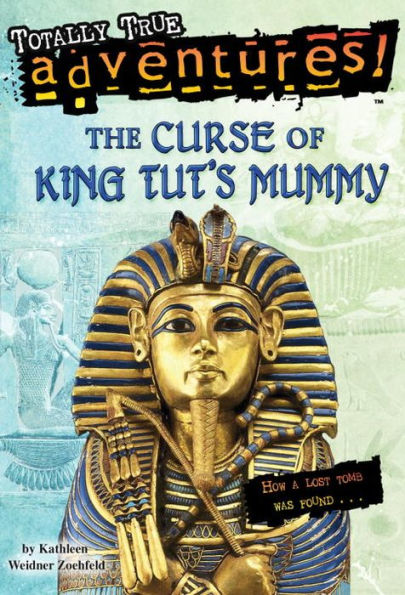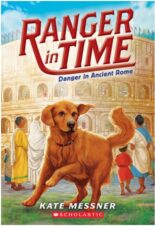
Buy This Book
“No one had ever found Akhenaten’s mummy. But historians knew that King Akhenaten ordered his tomb to be built near his capital city. When Tut died, did he want to be buried in the Valley of Kings? Or did he ask to be buried near his father’s city, many miles to the north?” Carter. –The Curse of King Tut’s Mummy
The Curse of King Tut’s Mummy
Totally True Adventures
by Kathleen Weidner Zoehfeld
AR Test, Good for Reluctant Readers
7+
Score
4.6
112
The desert hides many secrets. Day after day, Howard Carter and his crew search the sand for signs of Egypt’s ancient kings. Many tombs were looted long ago, but he was sure that one was still out there—the tomb of King Tut! But were the old stories true? Did King Tut’s mummy and the royal treasure come with a deadly curse?
Follow Howard Carter’s story, beginning when he was just a sickly child who fell in love with ancient Egypt. Through Carter’s experiences, readers will begin to see how education, perseverance, and endurance helped Carter find King Tut’s tomb. Even though Carter was thrilled to find King Tut’s treasures, he knew the importance of recording every artifact’s location and preserving the find for future generations. The end of the book contains Tut’s Mummy Timeline, photographs, and additional interesting facts.
The Curse of King Tut’s Mummy uses short chapters and easy vocabulary, which makes the book accessible to young readers. Large black and white illustrations appear every 3 to 7 pages and bring many of the ancient artifacts to life. While the book is easy enough for young fluent readers, the content will be interesting to older readers as well.
The Curse of King Tut’s Mummy explores ancient Egypt’s culture and beliefs in a way that makes archeology fun. The book is full of interesting facts. Detailed illustrations show the inside of many of the tombs. Anyone who is interested in Egypt’s ancient kings will enjoy The Curse of King Tut’s Mummy. Zoehfeld discusses some of the curses written on the tombs and some of the Egyptian superstitions, but she makes it clear that curses are not real. Younger readers who want to learn more about King Tut can jump back into time by reading Escape from Egypt by Wendy Mass.
Sexual Content
- None
Violence
- Carter was an archeologist who had to fight off rude tourists who came to visit a tomb. Carter “asked the rowdy visitors to leave. They demanded to be let into the tomb. The guards tried to block their way. The tourists threw chairs. They swung their walking sticks at the guards.” Two tourists were injured. The tourists also “damaged the walls and broke chairs.”
- The reason King Tut died is still unknown, but “the bone just above his left knee was broken.” Some speculate that “the young king had a bad accident during a battle or a hunting trip. The accident that broke his leg might have also crushed his chest.”
Drugs and Alcohol
- During ancient times, there was a funeral for the dead king where the guests’ “cups had been filled with beer and wine.”
Language
- None
Supernatural
- When an ancient Egyptian official and his wife were buried, their tomb had a warning: “All people who enter this tomb. Who will make evil against this tomb. And destroy it: May the crocodile be against them on water, and snakes against them on land. May the hippopotamus be against them on water. The scorpion against them on land.” Many believed that anyone who destroyed the tomb would be cursed.
- When Carter went to Egypt, he took his pet canary. Carter’s Egyptian housekeeper and his three foremen thought, “the bird of gold will bring us good luck!”
- Later that summer, a cobra got into the canary’s cage. “The deadly snake was gulping the poor bird down, headfirst. . . Carter’s housekeeper and foremen were horrified. They thought it was a sign of terrible things to come.”
- When there was a blackout, “many believed this blackout was a bad omen.”
- King Tut’s tomb had a warning: “For those who enter the sacred tomb, the wings of death will visit them quickly.” There were many stories of curses, but they “were all made up.”
Spiritual Content
- Ancient Egypt’s gods and goddesses are occasionally discussed because there were many statues of them. For example, “the Egyptian goddess of good health was always shown as a woman with a lion’s head.”
- In the 14th century B.C., “Akhenaten felt that Egyptian priests were getting too powerful. So he banned all the gods the Egyptian people were used to worshiping. He created a new religion with only one god.”
“No one had ever found Akhenaten’s mummy. But historians knew that King Akhenaten ordered his tomb to be built near his capital city. When Tut died, did he want to be buried in the Valley of Kings? Or did he ask to be buried near his father’s city, many miles to the north?” Carter. –The Curse of King Tut’s Mummy
Latest Reviews

Pride: A Pride & Prejudice Remix

Thieves’ Gambit #1

Dreamology

Monday’s Not Coming

Pinkalicious

Driven

Goodbye Days

Blood of Troy

Will’s Race for Home








